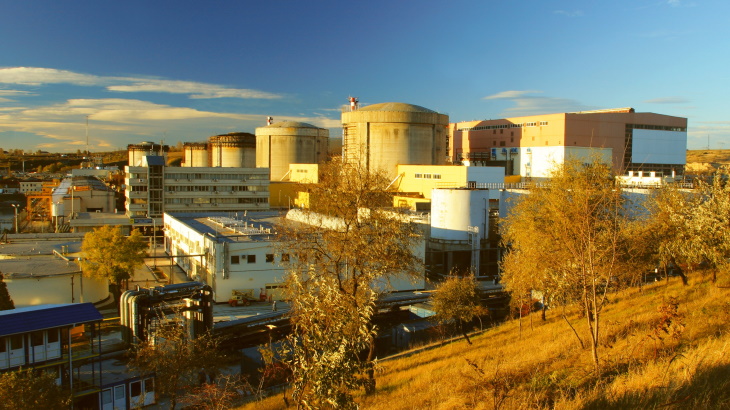Romania's Nuclearelectrica has secured a loan agreement of EUR145 million (USD159 million) with the European Investment Bank (EIB) towards the completion of what will be Europe's first Tritium Removal Facility, at the Cernavoda nuclear power plant.

The Cernavoda plant is in the southeast of Romania (Image: Nuclearelectrica)
As Candu pressurised heavy water reactors age, tritium - an isotope of hydrogen - accumulates in its moderator and heat transport systems. Increased levels of tritium can significantly contribute to personnel dose rates and emissions levels in the environment. Tritium removal technology is designed to capture and process tritium so that it can be properly stored and recycled, thereby reducing environmental impact, personnel exposure levels and enhancing workplace safety.
The Cernavoda tritium removal facility - the world's third, and the first in Europe - will use technology developed by the Romanian National Research and Development Institute for Cryogenic and Isotopic Technologies, a scientific research and technological development unit under the coordination of the Ministry of Research, Innovation and Digitalisation.
The tritium removal facility will include several high-technology areas: liquid phase isotopic separation, cryogenic distillation and high-vacuum operation. The tritium extracted will be stored in secure and safe specialised containers ready for future use.
The loan agreement was announced on 22 December. Cosmin Ghiță, Nuclearelectrica CEO, said: "Cernavoda Tritium Removal Facility will be the world's third and Europe's first tritium removal facility and will give Romania the opportunity to become a European hub for tritium production and export - the fuel candidate of future clean fusion reactors. We are happy to implement a Romanian innovative technology, based on years of research and development, a true statement of Romania's leadership in nuclear industry."
EIB Vice-President Kyriacos Kakouris said: "The EIB is financing sustainable energy projects worldwide and we are glad to support this project with health, safety and circular economy benefits undertaken by an experienced promoter."
The EIB is the long-term lending institution of the European Union and makes long-term finance available for projects pursuing EU policy goals. Its approach to nuclear projects was defined in its Energy Lending Criteria 2013, outlining a technology neutral approach "in line with the European Union's decarbonisation goal and the objectives of ensuring security of energy supply and competitiveness in an environmentally sustainable, cost-efficient, effective, safe and socially acceptable way".
Cernavoda is the only nuclear power plant in Romania and consists of two 650 MWe Candu-6 reactors. Unit 1 went into commercial operation in 1996 and unit 2 in 2007. Nuclearelectrica plans to extend the operating life of unit 1 to 60 years. Tritium removal facilities are already in operation at Ontario Power Generation's Darlington plant and Korea Hydro & Nuclear Power's Wolsong plant, both home to Candu reactors.
In June Korea Hydro & Nuclear Power signed an engineering, procurement and construction contract worth KRW260 billion (USD200 million) with Nuclearelectrica following a public procurement process. The project completion timeline is estimated to be 50 months.
Researched and written by World Nuclear News